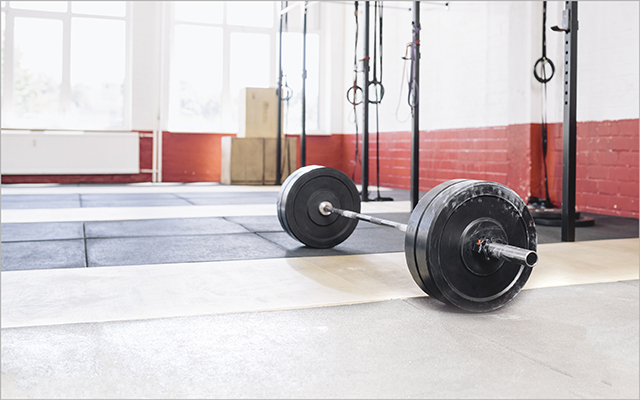Several recent studies have raised alarms about a dramatic increase in cases of rhabdomyolysis, a rare but life-threatening condition caused by severe muscle trauma. Researchers say rhabdo is on the rise due to the growing popularity of intense workout programs ranging from CrossFit to spinning — and it can affect first-timers as well as elite athletes.
“Rhabdo usually occurs due to extreme muscle strain in an athlete that is exposed to too much too early,” explains David Freeman, NASM-PES, signature program managerof Life Time’s Alpha Training. The condition may occur when exercisers don’t allow their muscles to adjust to an aggressive new workout.
A certain amount of stress to muscles is part of any exercise, stimulating them to grow and adapt to stress. But overworked muscles can die and leak their contents — including electrolytes and proteins such as myoglobin — into the bloodstream, straining the kidneys and causing severe pain, according to kidney researcher Maureen Brogan, MD, lead author of a recent rhabdo study.
Symptoms range from fatigue, fever, nausea, and vomiting to intense muscle soreness and swelling. Often, urine turns dark from the myoglobin filtered from the blood. In serious cases, it can lead to kidney failure.
The following advice can help safeguard you from rhabdo:
- Select a workout that fits your fitness level. If you’re new to a program, start with a beginners’ class and inform the instructor that it’s your first time. “The level of intensity at which you should work out depends on your current level of fitness,” says Brogan. “If you are physically fit, you can start at a higher intensity. If you are recruiting new muscle groups that you haven’t used in a while, then the duration and intensity of the workout should be slower and lower.”
- Hydrate! “It is important to drink before, during, and after any workout. And avoid hot environments where you can lose excess water,” she explains.
- Avoid NSAIDs before and after exercise. Nonsteroidal anti-inflammatory drugs, such as aspirin, ibuprofen, and naproxen, can increase the risk of kidney damage. (See “This Is Your Body on Ibuprofen” to learn how NSAIDS can cause more pain than they relieve.)
- Refrain from taking a second class for several days, Freeman advises, to make sure you are OK.
- Seek medical help immediately for any symptoms like dark urine, swelling, or thigh weakness. “Go to the ER if you notice dark urine postworkout, swelling and weakness in your thighs that cause difficulty walking or going up stairs, or just not feeling well for any reason,” Brogan says. “And note that some symptoms can take up to a few days to develop.”
Q&A With Maureen Brogan, MD
Experience Life | What advice can you offer to exercisers about knowing their limits or watching out for symptoms of rhabdomyolysis while doing aggressive, intense workouts — especially workouts that are new to them?
Maureen Brogan | The level of intensity at which you should work out depends on your current level of fitness. If you are very physically fit, you can start at a higher intensity. If you are recruiting new muscle groups that you haven’t used in a while, then the duration and intensity of the workout should be slower and lower. For any new exercise, you should avoid hot environments where you can lose excess water. It’s important to drink before, during and after any new workout. If you notice muscles soreness, stiffness, swelling, fatigue, or dark urine, you should seek medical care.
EL | What’s happening biologically with rhabdomyolysis?
MB | During intense exercise, the muscles may not get enough oxygen, and inflammation and swelling may occur around the broken muscle cells later. The muscle-cell breakdown may cause electrolyte abnormalities, including high potassium and high phosphorus and low calcium, putting the patient at risk of cardiac arrhythmias and seizures. When the muscle cells break down, they also release a protein called myoglobin, which needs to be cleared by the kidney and can directly injure it.
EL | How quickly might you start noticing symptoms coming on?
MB | Early symptoms of rhabdomyolysis may include lightheadedness, feeling of nausea, weakness, or muscle soreness while spinning. Some symptoms can take up to two days to start to develop. Late symptoms may include dark urine, muscle swelling, and weakness.
EL | How important is staying hydrated to preventing rhabdo, and why?
MB | It is important to stay hydrated while spinning since you can lose up to 1 liter an hour of sweat while spinning. Staying hydrated maintains blood pressure, which supports proper circulation to your muscles, kidneys, and all organs.
EL | Can taking NSAIDs before such exercise have an effect on developing rhabdo?
MB | Taking NSAIDs causes constriction of oxygen-carrying blood vessels in the kidneys, increasing the risk of kidney damage.
EL | What are the signs that you should seek medical help?
MB | Go to the ER if you notice dark urine postworkout, development of swelling and weakness in your thighs that cause difficulty walking or going up stairs, or just not feeling well for any reason. And note that some symptoms can take up to a few days to develop.




This Post Has 0 Comments